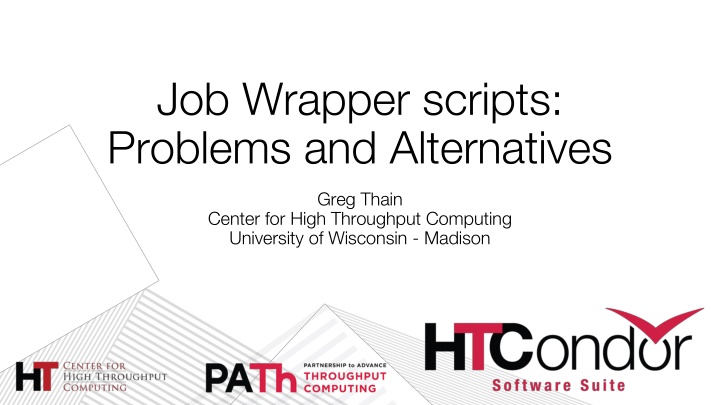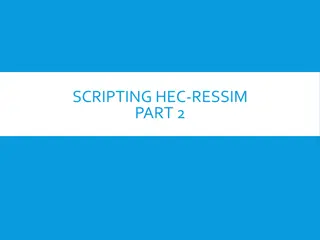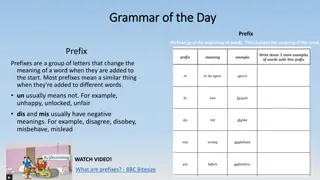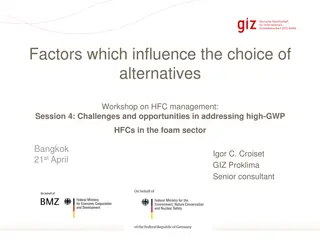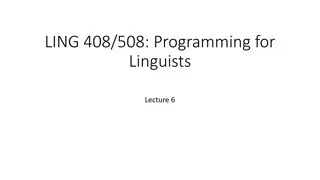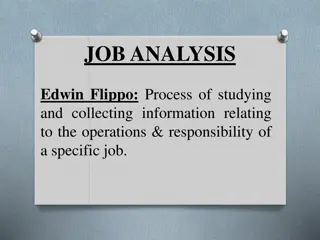Job Wrapper Scripts: Problems and Alternatives
The challenges in reliably running jobs on high-throughput computing systems, addressing issues such as machine crashes, network hiccups, and disk failures. Discussing solutions and ways to enhance reliability in job execution under HTCondor environment.
Download Presentation

Please find below an Image/Link to download the presentation.
The content on the website is provided AS IS for your information and personal use only. It may not be sold, licensed, or shared on other websites without obtaining consent from the author.If you encounter any issues during the download, it is possible that the publisher has removed the file from their server.
You are allowed to download the files provided on this website for personal or commercial use, subject to the condition that they are used lawfully. All files are the property of their respective owners.
The content on the website is provided AS IS for your information and personal use only. It may not be sold, licensed, or shared on other websites without obtaining consent from the author.
E N D
Presentation Transcript
Job Wrapper scripts: Problems and Alternatives Greg Thain Center for High Throughput Computing University of Wisconsin - Madison
Reliably running jobs (even on unreliable places) Greg Thain Center for High Throughput Computing University of Wisconsin - Madison
Outline A Very Short talk about "reliability" Review of how HTCondor runs jobs Problems with wrappers under HTCondor Discuss solutions (some new, some old) With the occasional simplification indicated by*
What do we mean by running jobs reliably Never having a problem? No machine crashes No network hiccups No disk failures? No machine running slower than it should?
Why do we accept the existence of failures? We have to A) We get more machines to use. HTC should be happy to run on imperfect machines e.g. gamer gpus B)
For us, reliability means We can detect errors We can classify errors We can report errors We can respond to errors This one is beyond our scope of this talk
condor_starter runs the job on the EP* Makes a scratch directory, e.g. /var/lib/execute/dir_1234 Starts the program named in the executable = line in the submit file
How you think of your program Makes a scratch directory, e.g. /var/lib/execute/dir_1234 https://commons.wikimedia.org/w/index.php?curid=86139361 Starts the program named in the executable = line in the submit file By AkanoToE - Own work, CC BY-SA 4.0,
How you think of your program Makes a scratch directory, e.g. /var/lib/execute/dir_1234 Starts the program named in the executable = line in the submit file
How you think of your program Makes a scratch directory, e.g. /var/lib/execute/dir_1234 Starts the program named in the executable = line in the submit file
How HTCondor sees your program* Makes a scratch directory, e.g. /var/lib/execute/dir_1234 Starts the program named in the executable = line in the submit file Just an opaque box
But not quite perfectly opaque.. HTCondor knows Memory usage inside box CPU/GPU usage inside box Disk usage inside box Wall clock time and . Exit code of job's main process (!) (and some other stuff) And sends this back to the AP! And sends this back to the AP!
Let's talk about exit codes Unix exit code is eight bits a program returns to parent at exit ONLY WAY the program can communicate to the starter* By convention "zero" (0) means "good", all else "bad" But that's just a convention TRIVIA: What's the exit code for the "grep" program?
HTCondor does what about exit codes? Pure HTCondor doesn't do anything (just records them) Should it hold job with non-zero exit? Remove? Send email? DAGMan has more options can resubmit By default, dagman assumes non-zero exit is failure, and blocks DAG But HTCondor gives you knobs max_retries = 7 success_exit_code = 0
Ok, so what's all this about shell scripts? Exit code of a script is either Argument to exit shell builtin function OR Exit code of last command the script ran
Typical shell script for a job looks like #!/bin/sh some_setup some_more_setup the_actual_executable some_cleanup some_more_cleanup
Pop Quiz: what's the exit code? #!/bin/sh some_setup some_more_setup the_actual_executable some_cleanup some_more_cleanup
Pop Quiz: how can we fix this? #!/bin/sh some_setup some_more_setup the_actual_executable some_cleanup some_more_cleanup
Doesn't seem to hard to fix at first #!/bin/sh some_setup some_more_setup the_actual_executable saved_exit = $? some_cleanup some_more_cleanup exit $saved_exit
But to fix everything is tedious, and error-prone #!/bin/sh some_setup some_more_setup What if there is an error here? the_actual_executable saved_exit = $? some_cleanup some_more_cleanup exit $saved_exit Is this kind of error the same as a job error? Do we want to respond the same way?
What's the bigger picture? #!/bin/sh some_setup some_more_setup Setup the environment the_actual_executable some_cleanup some_more_cleanup Cleanup the environment
Remember how HTCondor sees the job? Fundamental Problem: HTCondor can't differentiate a setup/cleanup problem From a bona-fide job problem (and we want to treat these differently)
That is to say Wrappers hide activity from HTCondor Error codes are NOT sufficient! And error codes belong to the job No Unix error for "failed to xfer sandbox" Some Belong to the HTCondor domain
The proper fix HTCondor EP mkdirs scratch directory Starts the job some_setup some_more_setup the_job_itself some_cleanup some_more_cleanp
This is a common CS pattern Separating initialization / teardown from main work Object Oriented Constructors/Destructors do this Two Phase commit "Prepare Tran" And HTCondor knows all about errors in parts it manages So it can send them back home to the AP to make decisions
The means translating shell into submit Some work, worth it, not too hard. Read submit man page for all possibilities Some examples follow
Wrapper Env var Submit language universe = vanilla #!/bin/sh environment=MYVAR=hello queue export MYVAR=hello ..
Wrapper Env var Submit language #!/bin/sh universe = vanilla export AHOME = \ $(pwd)/sdir .. environment= \ AHOME=$$(CondorScratchDir)/sdir queue
Wrapper untar Submit language universe = vanilla #!/bin/sh transfer_input_files = a/ queue tar xzf a.tgz .. rm fr a/
Wrapper wget Submit language universe = vanilla #!/bin/sh transfer_input_files = \ http://... queue wget http://.. .. rm fr a/
Wrapper wget + untar Submit language universe = vanilla #!/bin/sh transfer_input_files = \ http+tar://... queue wget http://.. tar xzf a.tar .. rm fr a/
Summary The more we tell HTCondor to do, the better outcomes A bit of work to translate familiar shell to submit, but worth it But not all or nothing What are we missing that you still need these kinds of wrappers?
Thank you and questions Thank you Questions? This work is supported by the NSF under Cooperative Agreement OAC-2030508. Any options, findings, conclusions or recommendations expressed in this material are those of the authors and do not necessarily reflect the views of the NSF.
